Editor’s Note: The Center for Carbon Removal in Berkeley, California, is on a mission “to accelerate the development of scalable, sustainable, economically viable carbon removal solutions”.
An initiative of the Berkeley Energy and Climate Institute, the Center conducts research and analysis, hosts networking events with public and private sector professionals, and curates an online hub of information and discussion on the topic.
Noah Deich is the executive director of the Center and recently attended the global climate talks in Paris. There he heard about a range of initiatives and technologies that the agriculture sector could adopt to play its part in reversing global warming.
—————
At the COP21 climate talks in Paris in December, the world agreed to an ambitious climate goal: “holding the increase in the global average temperature to well below 2°C above pre-industrial levels and to pursue efforts to limit the temperature increase to 1.5°C above pre-industrial levels.”
But at the same time, countries submitted individual climate action plans that collectively fall far short of what is needed to meet these goals.
This ‘climate ambition gap’ means heavy-emitting industries across the globe will need to transform rapidly to build the low-carbon economy of the future, and the agriculture industry is no exception.
Here are three ways the agriculture and technology industries can respond to climate change while producing enough food to feed the growing world population.
1. STOP producing GHG emissions
Limiting temperature increases to 2oC (let alone 1.5oC) means that we cannot just slow down emissions, we need to stop GHG emissions altogether and do so rapidly. Leading scientific publications from groups such as the Global Carbon Project show that current GHG emissions trajectories have us on pace to reach 2oC of warming in only 20 years, even if the climate action plans submitted in advance of COP21 are implemented as promised.
Transitioning away from GHG emissions will be no small feat for the agriculture sector, which generates around 10 billion tons of Co2-equivalent GHG emissions, according to the Food and Agriculture Organization (FAO). This is around 20 percent of total global emissions per year. The chart below highlights the range of activities producing greenhouse gasses.
Global agriculture GHG emissions by source

Source: FAO (2014)
Fortunately, there is a range of GHG abatement strategies that farmers and ranchers can pursue to reduce drastically emissions:
Efficiency and intensification. There a range of emerging agriculture technologies that can enable farmers to grow more food with fewer resources, namely precision agriculture tools. From soil moisture and nutrient sensors to crop-scouting drones and satellites, these technologies can help farmers maximize their yields. Increasing the productivity of existing farmland like this will reduce the pressure to convert carbon sinks — anything that absorbs more carbon than it releases such as forests and wetlands — to agricultural use. Conversion of natural lands to farmland is a key driver of GHG emissions today in tropical areas such as Brazil and Indonesia.
Renewable energy. Renewable energy sources can be used to power a wide range of agricultural activities, from low-carbon transportation and farm equipment to the production of fertilizers and other farm inputs. Farmers can even produce renewable power themselves by turning crop residues and animal waste into bioenergy through processes like anaerobic digestion. And as renewable power becomes less expensive, it could be used to power indoor agriculture efforts too. This developing segment of agtech can help meet the growing demand for local food production in urban areas and, in turn, reduce GHG emissions associated with food transportation.
2. DROP the level of GHG emissions in the atmosphere
Stopping or reducing GHG emissions alone is unlikely to suffice if the world is to meet its climate goals; we also need to find ways to remove GHGs that remain in the atmosphere from past decades of industrial activity.
In fact, we will need net-negative emissions by 2100 if we’re to keep global temperatures at or below 2oC, according to 9 out of 10 presentations analyzed by the Intergovernmental Panel on Climate Change (IPCC). GHGs are sticky; they remain in the atmosphere for centuries if left to natural processes alone, so if we ‘overshoot’ our GHG emissions budget, we must remove GHGs to meet climate goals.
The good news is that agriculture offers enormous potential to serve as a carbon sink, in effect mopping up excess GHGs from the atmosphere, because of the carbon-storing capabilities of healthy soil. At COP21, a range of agricultural GHG sequestration proposals were on display, such as the 4 per 1000 soil carbon initiative, the Bonn Challenge landscape restoration effort, and the Great Green Wall afforestation project.

In addition, land managers have a number of other strategies to build up carbon in soils. This Project Drawdown video summarizes the wide range of “carbon farming” strategies.
Advances in biotech to perennialize crops to require less GHG-intense cultivation also hold great potential to build up soil carbon levels. As do bio-pesticides and other biological fertilizers, such as biochar, which help farmers to increase their yields while improving the health of the soil and reducing soil carbon erosion.
Lastly, innovations to turn marginal or degraded land back into productive, carbon sequestering-acreage will fetch higher and higher premiums as the demand for terrestrial carbon sequestration makes fertile land more valuable.
ROLL: Farmers must adapt to climate change now
As evidenced by the dialogue at COP21, farmers around the world are increasingly looking for ways to respond to and mitigate the risks from weather extremes exacerbated by climate change. For one, farmers are turning to advanced weather data services to understand how the climate is changing. Also, land managers are looking back to the future to employ more ecological and holistic farming practices such as agroforestry and holistic cattle ranching. These can have greater resilience to volatile weather conditions than the industrialized agriculture production techniques predominant today. Genetic advancements can also help crops to become resilient to extreme weather, such as drought-resistant rice in Southeast Asia.
It appears that governments around the world have heard this message on climate adaptation, as they are providing significant resources to help farmers adapt to changes in climate. Initiatives such as the Adaptation Fund have already deployed millions of dollars in funding for projects, and the Paris Agreement text ensured that funding for adaptation will remain a key topic at future UN climate conferences.
Caption: Climate adaptation solutions such as Agroforestry were on display in the NGO area at COP21
Moving forward
The Paris Agreement coming out of COP21 makes it clear that land managers around the world will need to stop, drop, and roll to

respond to climate change. While many tools exist for low-carbon agricultural transformation, the key challenge for the world going forward will be to accelerate the deployment of these strategies to turn our ambitious climate goals into reality.
Want to write a guest commentary? Email [email protected]
Image credit: Pro-Soil Ag Solutions




